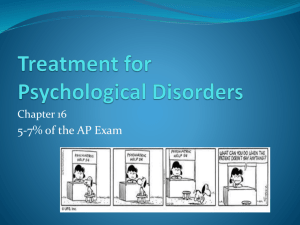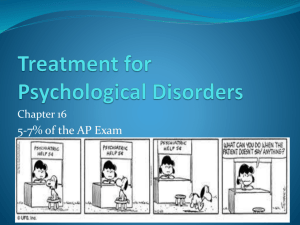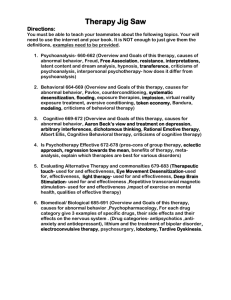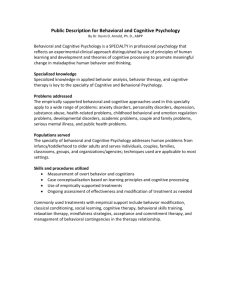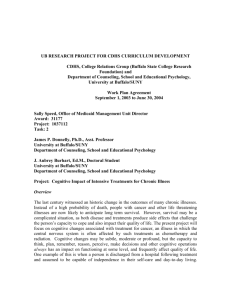Treatment for Psychological Disorders
advertisement
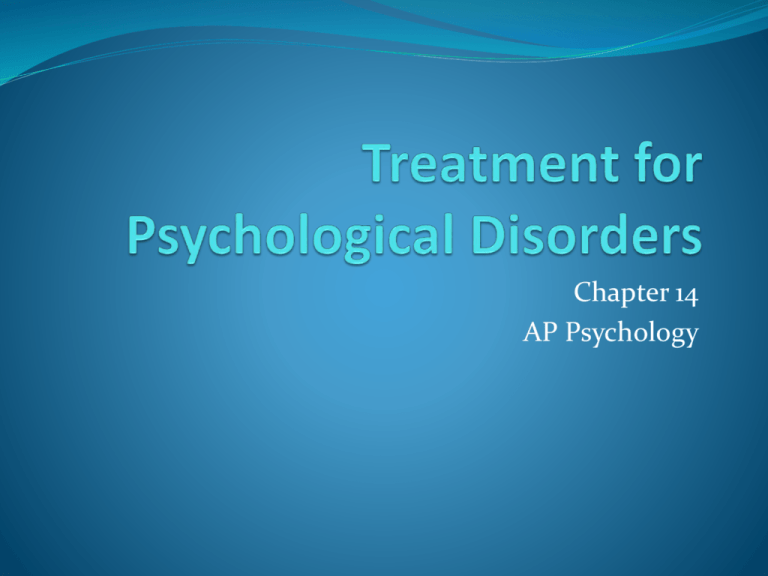
Chapter 14 AP Psychology Psychotherapy – An Overview The treatment of psychological disorders through psychological methods Clients Inpatients Outpatients Therapist Psychiatrists Psychologists Basic goal: to help people change their way of thinking, feeling, or behavior Psychoanalytic Psychotherapy Personality and behavior reflect the ego’s efforts to referee unconscious conflicts Psychoanalysis – understanding unconscious conflicts Freud’s one-on-one methods – free association, dream analysis, hypnosis Aims to help clients gain insight into and work through problems Manifest content Latent content Freudian slip Transference Resistance – when a person disagrees with the therapist’s interpretations – people try to protect themselves through resisting the truth –unconsciously blocks the process of revealing unconscious conflicts Contemporary Psychoanalysis Traditional psychoanalysis – too long and expensive Short-term psychodynamic therapy evolved – less expensive and time consuming Interpersonal therapy – helps clients cope with current problems and situations (work, marital issues, stress, loss, etc.) Humanistic Psychotherapy Phenomenologists Behavior is motivated by an innate drive toward growth – therapists help people to self-actualize People are innately good and possess free will – capable of controlling their own destinies Clients will improve on their own, given the right conditions Patients must feel totally accepted and supported – emphasis on relationships Humanistic (con’t) Client-Centered Therapy (Person-Centered Therapy) Carl Rogers – non-directive therapy - allowed clients to decide what to talk about and when, without judgment or direction – requires active listening Unconditional positive regard – blanket acceptance for a person Empathy Congruence Humanistic (con’t) Gestalt Therapy Importance of the whole Frederick Perls – encourage people to get in touch with their whole selves - make people aware of their environment, present feelings, and actions Gestalt therapy seeks to create conditions in which clients can become more self-aware and self-accepting Behavioral Therapy Clients see their problems as learned behaviors that can be changed, without searching for hidden meanings or unconscious causes Based on the work of Watson, Pavlov, & Skinner Features: Development of a productive therapist-client relationship Careful listing of the behaviors and thoughts to be changed – assessment and establishment of goals Learning-based treatments – giving “homework” Continuous monitoring and evaluation of treatment Techniques for Modifying Behavior Counterconditioning Mary Cover Jones Systematic Desensitization Joseph Wolpe Modeling Assertiveness and social skills training Positive reinforcement Token economy Extinction Flooding Aversive Conditioning Breaking a habit Operant Conditioning Reinforcement/Punishment Cognitive Therapy Focus is on changing unhealthy thought patterns Rational-emotive behavior therapy – Albert Ellis Cognitive Restructuring healthy v. unhealthy attributional style Aaron Beck – founder of Cognitive Therapy Most often used in treating depression Cognitive triad – people’s thoughts about themselves, their worlds, and their futures Aims to make these beliefs more positive Cognitive Behavioral Therapy CBT – Combines ideas of Cognitive and Behavioral psychologists Rational Emotive Behavior Therapy (REBT) – Albert Ellis Therapists look to expose and confront dysfunctional thoughts of their clients Based on the premise that when we become upset, it is not the events taking place that upset us – it is the beliefs we hold that cause us to become depressed ABC Model – teaches people how their beliefs cause their emotional and behavioral response Cognitive Behavioral Therapy (con’t) Ellis’ ABC Model A. Something happens B. You have a belief about that situation C. You have an emotional reaction to the belief For example: A. Your employer falsely accuses you of taking money from the register and threatens to fire you B. You believe, “She has no right to accuse me! What a jerk!” C. You feel angry ***B causes C Group, Family, and Couples Therapy Group Therapy – simultaneous treatment of several clients – no single theoretical approach used Advantages – allows interaction among clients, clients feel less alone (raised expectation for improvement), clients boost each other’s confidence, clients are more willing to share Anti-addiction groups Family & Couples Therapy – treatment of two or more from same family system – goal is to create harmony and balance Developed from psychodynamic theory – disorders are rooted in family conflicts Biological Treatments (Somatic Therapy) Somatic therapies – therapies that produce bodily changes Electroconvulsive Therapy (ECT) – “shock treatment” – used for depressive patients who didn’t respond to medication Early use – physicians passed electric currents through brains of people with schizophrenia Modern use – shock is applied to one side of the brain at a time – used to treat patients with severe depression, who do not respond well to medication Improves neurotransmitter functions? Controversial Psychosurgery – destruction of brain tissue for treating mental disorders Prefrontal lobotomy – severs neural connection between the prefrontal cortex and the rest of the brain Biological Treatments Psychoactive Drugs Neuroleptics (Antipsychotics)– reduce psychotic symptoms such as hallucinations, delusions, paranoia, & disordered thinking (Schizophrenia) Block receptor sites for dopamine Thorazine, Haldol Biological Treatments Psychoactive Drugs (con’t) Antidepressants – help relieve symptoms of depression – immediate effect on neurotransmitters (usually increasing serotonin or norepinephrine) Monoamine Oxidase Inhibitors (MAO-I) – treats panic disorder Tricyclic antidepressants (TCAs) – more effective in treating panic disorder Prozac – affects serotonin – most prescribed in the U.S. – also used for panic disorder and OCD Effexor, Serzone, Wellbutrin Antidepressants Biological Treatments Psychoactive Drugs (con’t) Lithium – mineral salt found to reduce frequency and intensity of manic and depressive phases of bipolar patients Anticonvulsants – treats mania Depakote Anxiolytics (tranquilizers) – treats anxiety – most widely prescribed and used of all legal drugs Xanax, Klonopin, Prozac, Paxil, Anafranil, Luvox, Zoloft Evaluating Psychoactive Drug Treatments Limitations – Drugs may cover up the problem without permanently curing it Relieve symptoms without addressing underlying causes Drug abuse – physical and psychological dependence Side effects
